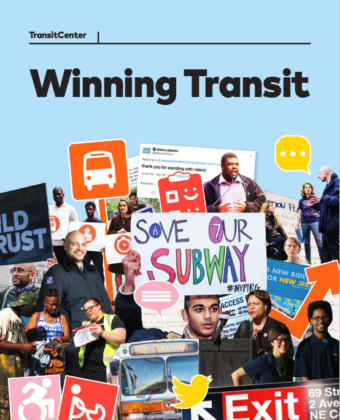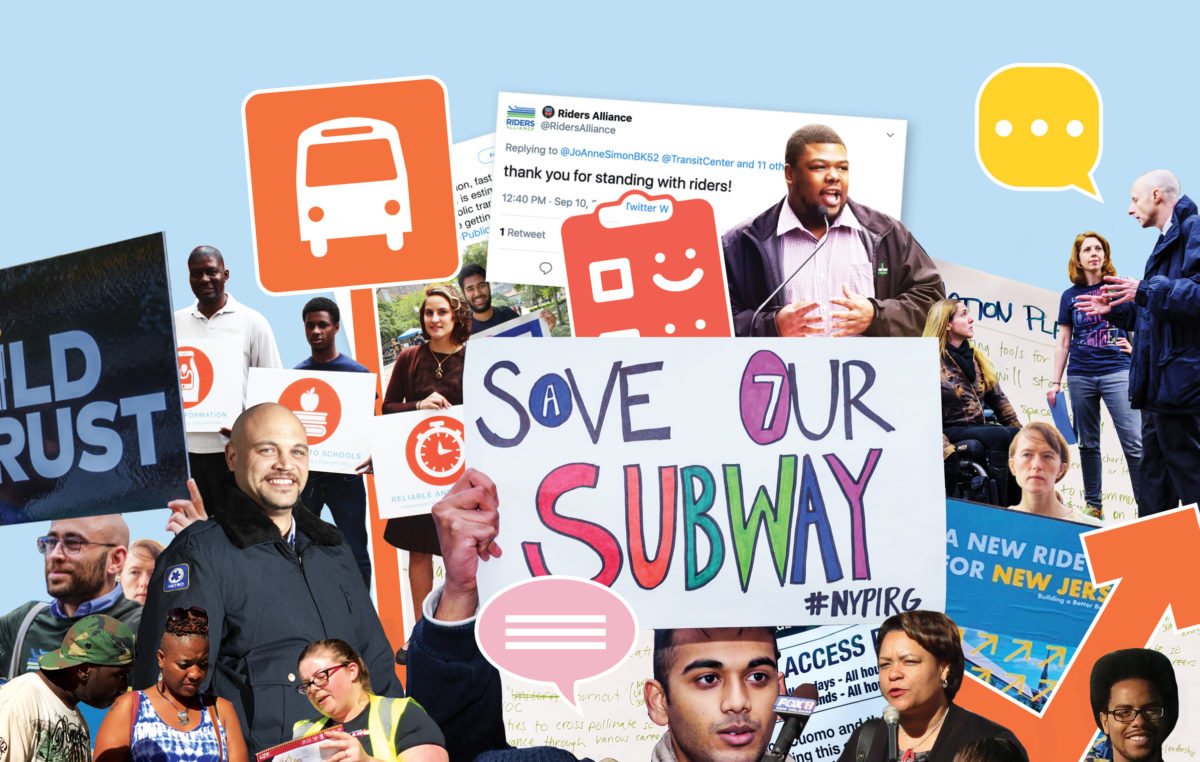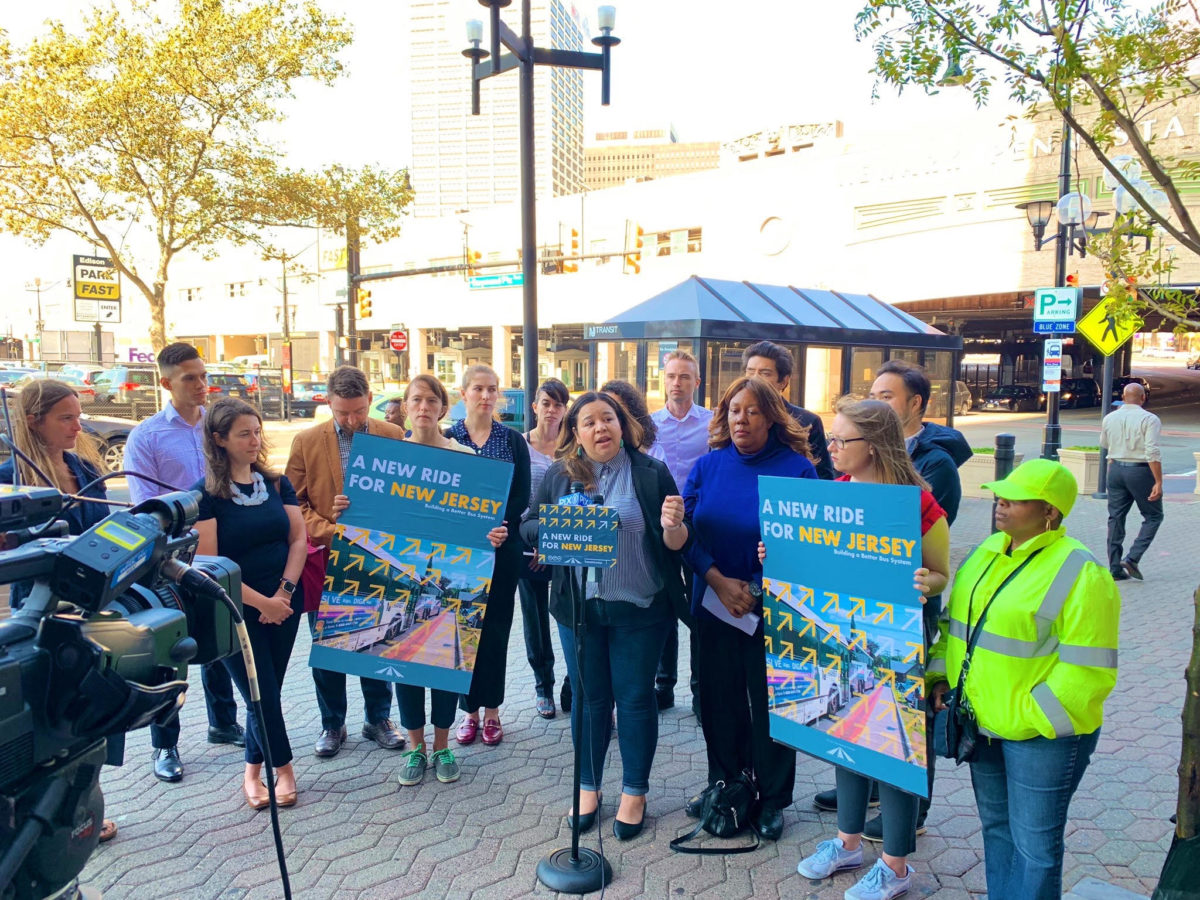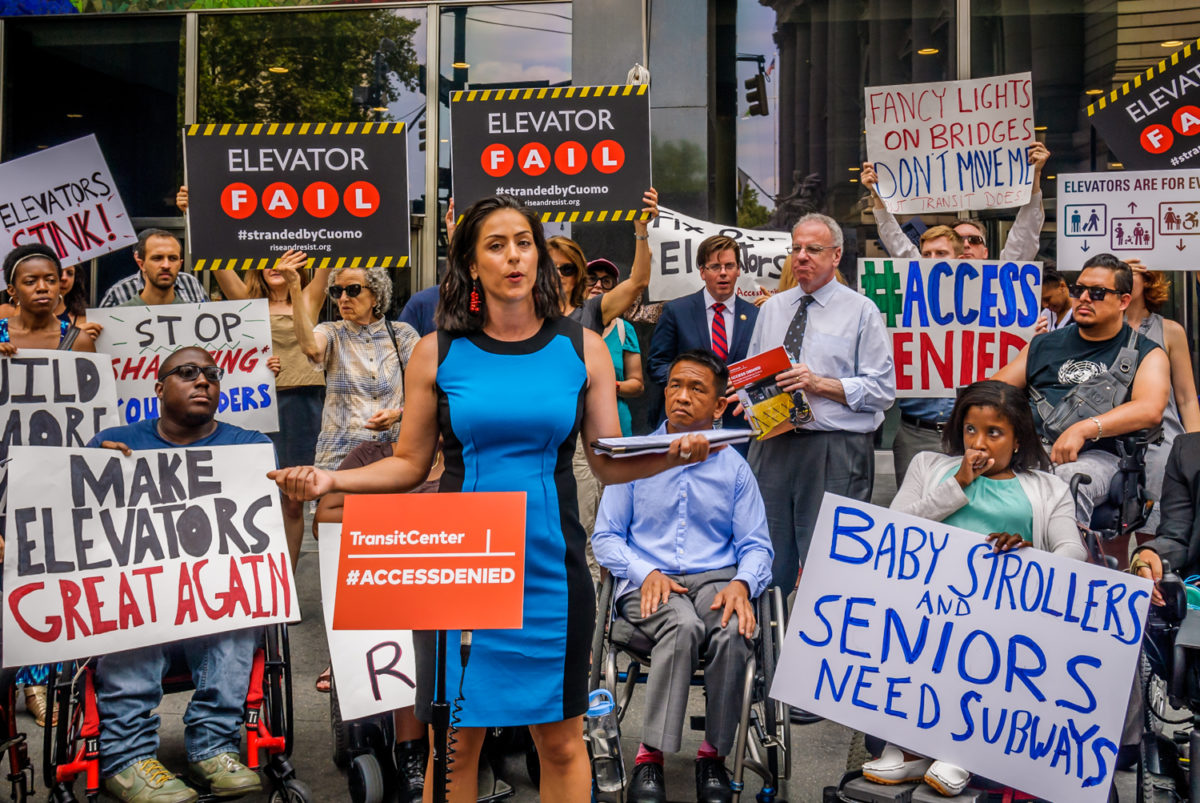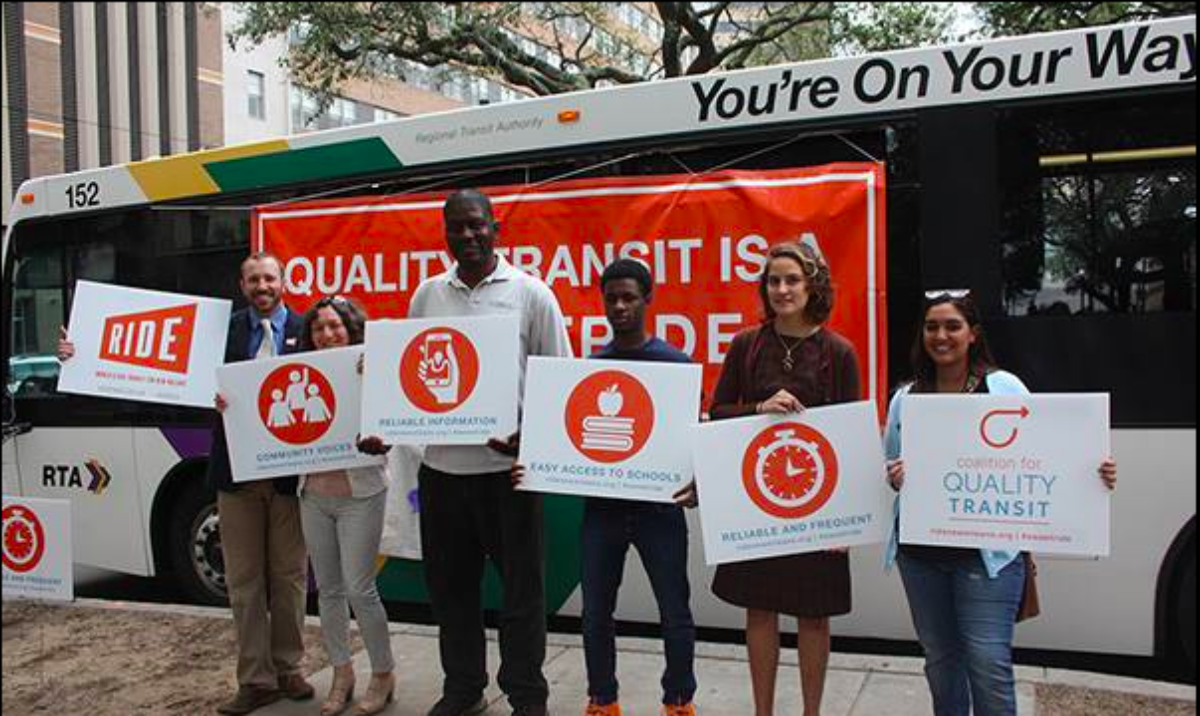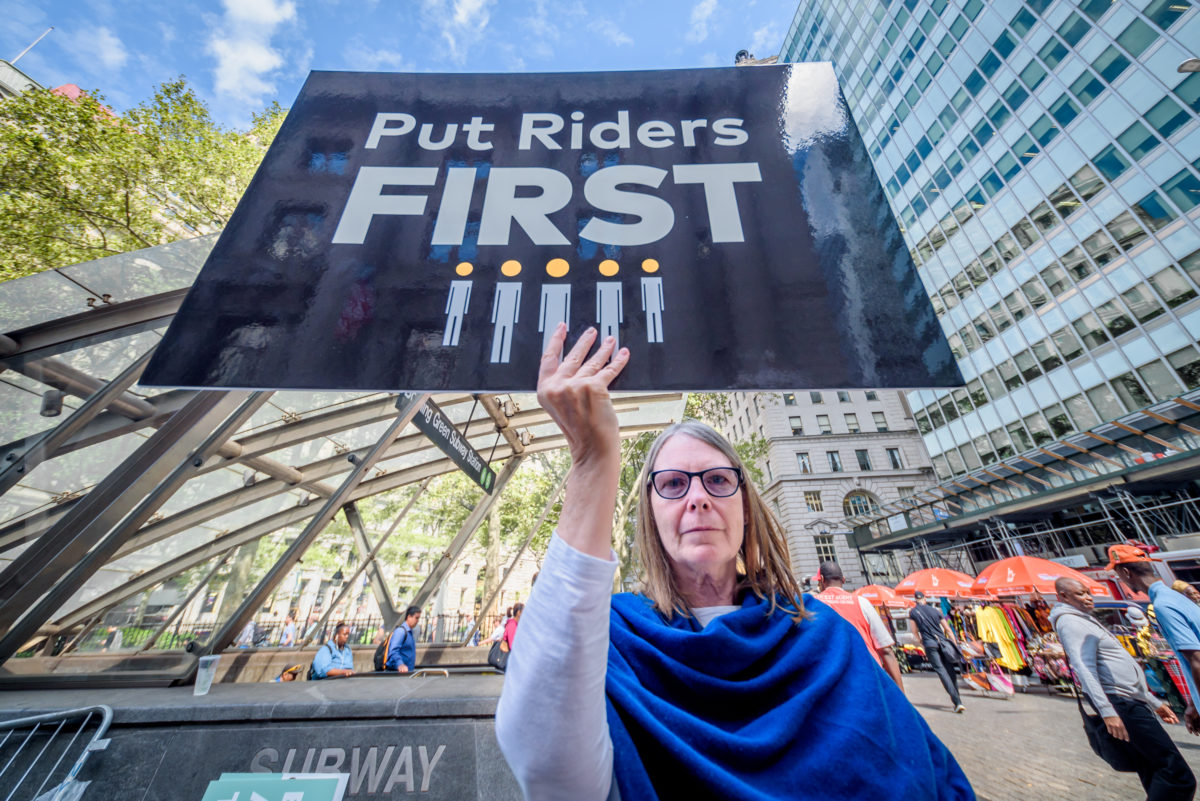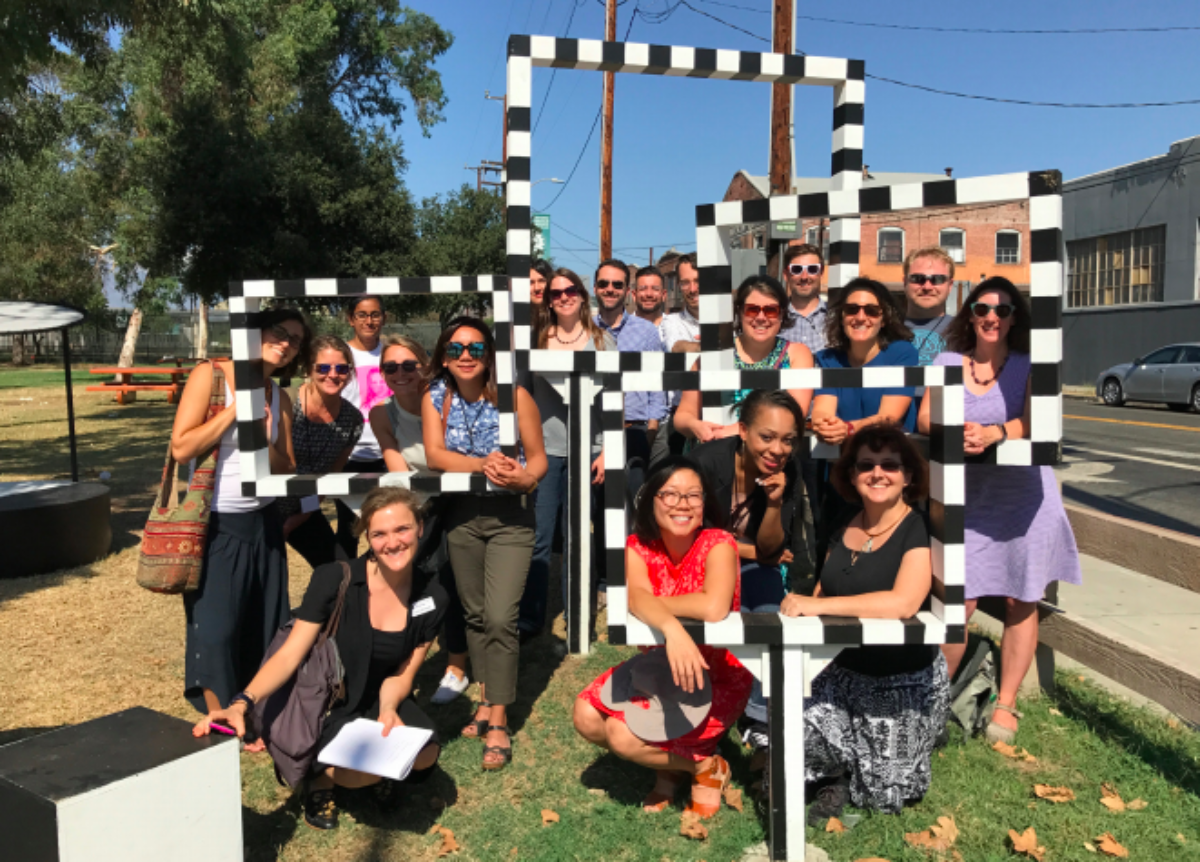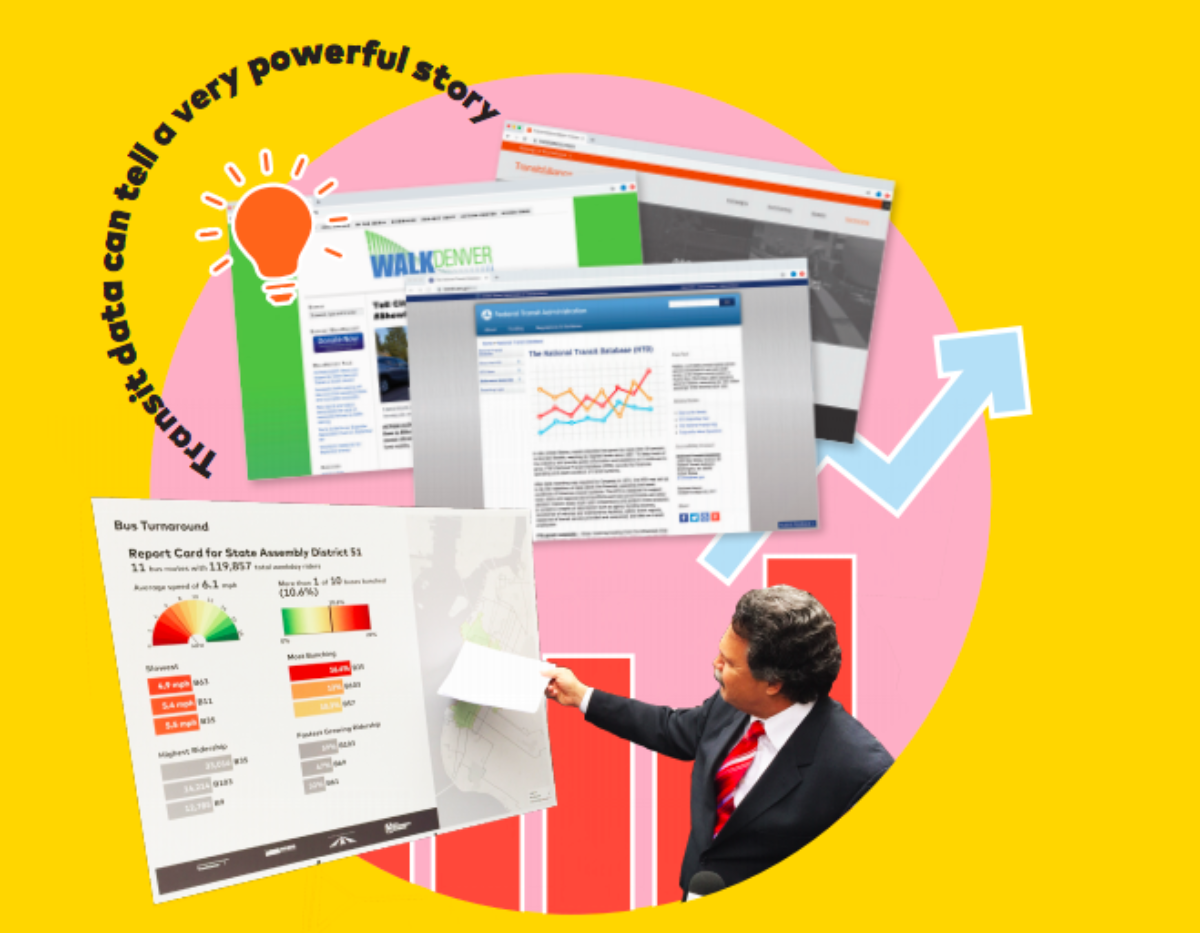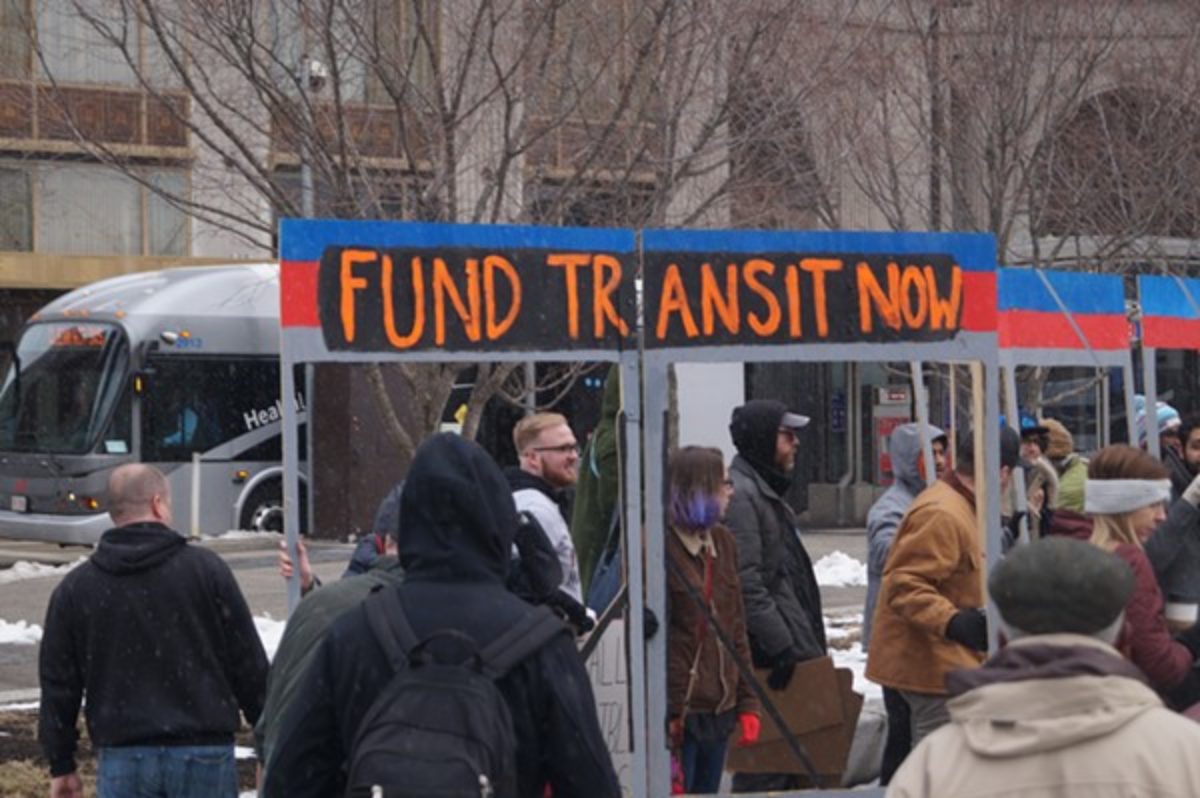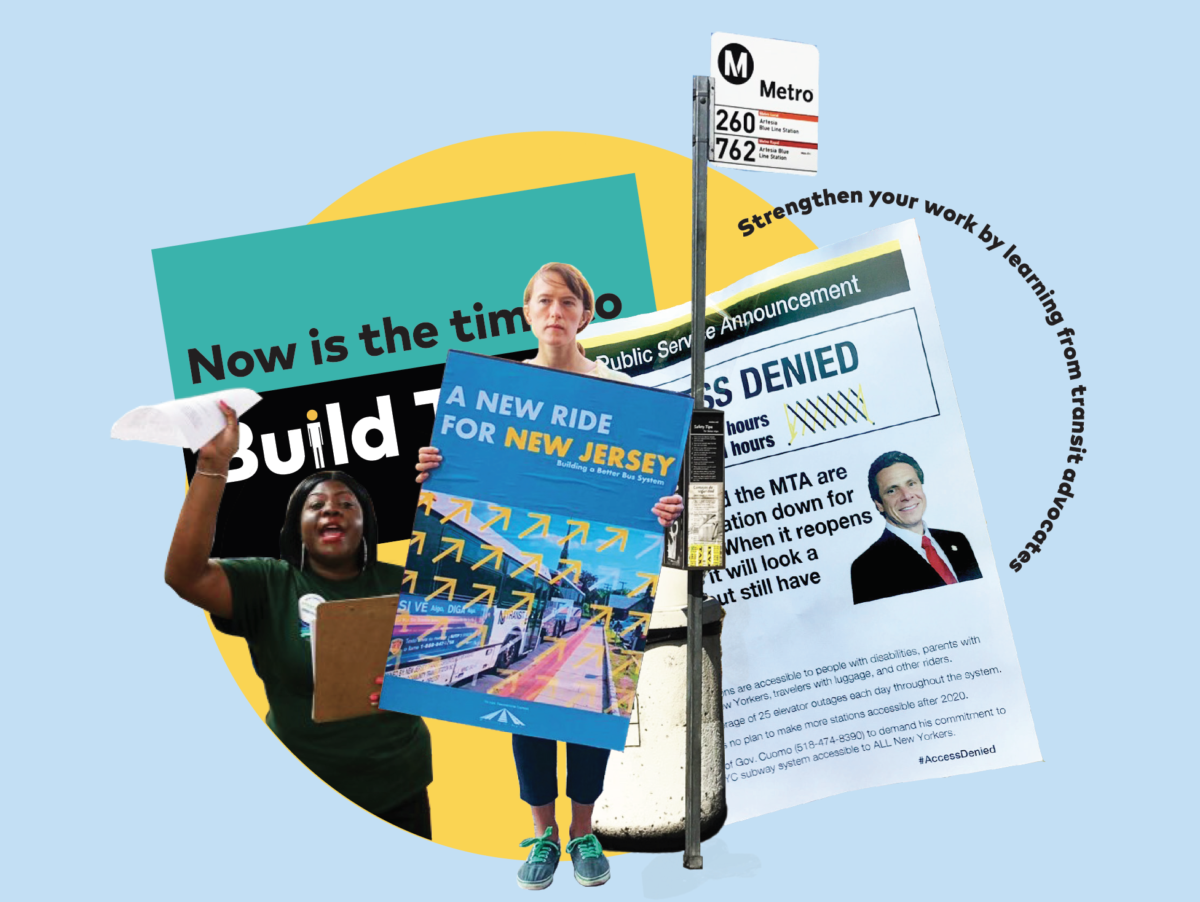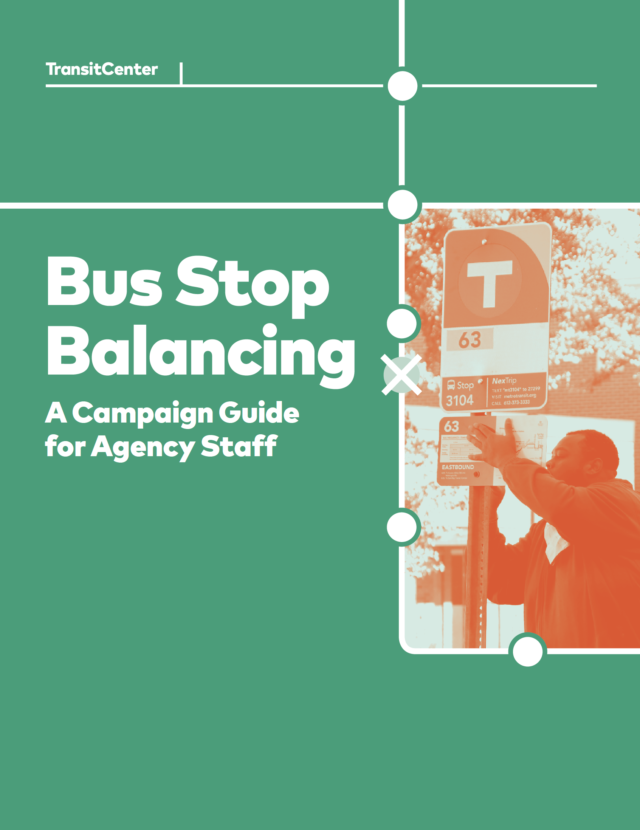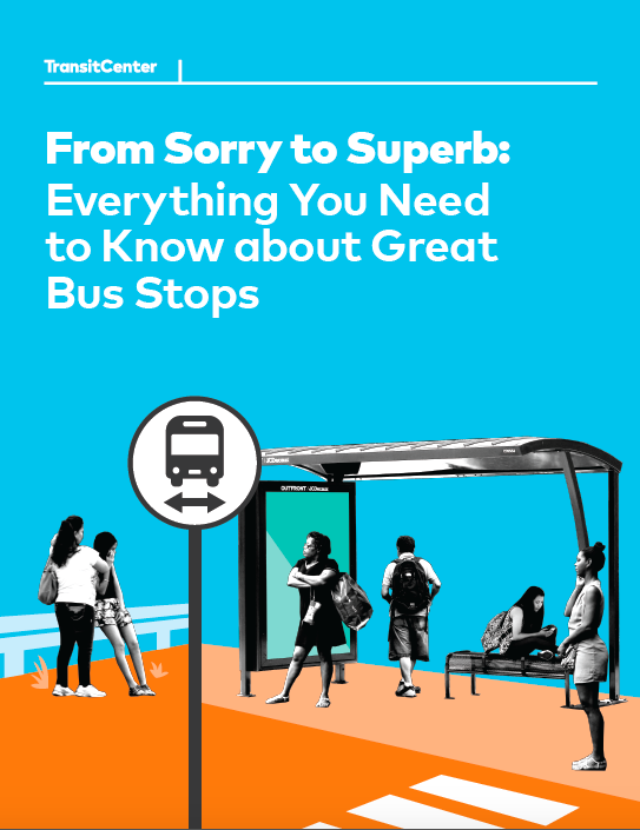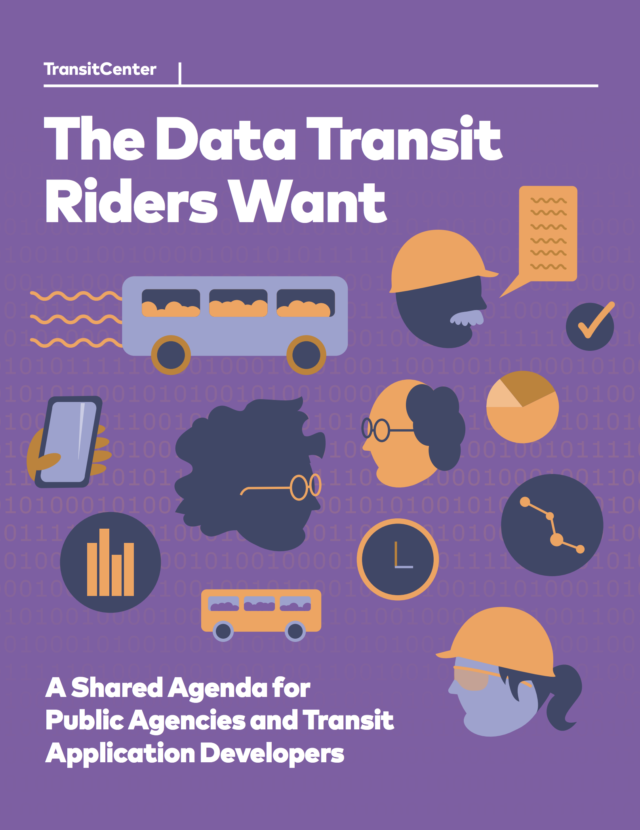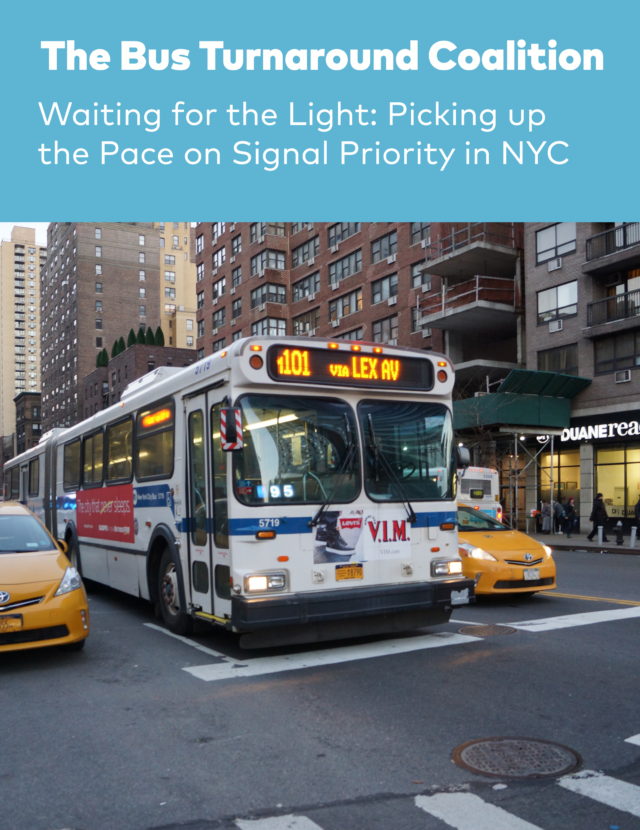Winning Transit Video: Riders Alliance's Campaign for Fair Fares in New York City
Winning Transit Video: TransitMatters' Campaign to Improve Commuter Rail in Boston
Six Steps for Winning Transit
- Set a vision for transit in your city.
- Set specific, ambitious, and attainable goals to realize that vision.
- Identify who can make those goals happen and hold these decision makers, typically political leaders, accountable.
- Speak from a rider’s perspective and combine human stories with compelling statistics.
- Use a variety of tactics to sustain pressure for change.
- Support and create opportunities for transit officials and agency staff to implement new policies and practices. Celebrate their progress.
Introduction
For the better part of a century, US transportation policy has overwhelmingly prioritized and subsidized private automobiles over transit and walking. Highways, wide roads, and parking dominate the urban landscape and are major features even in the most transit-friendly American cities. Lavishing financial and spatial resources on automotive travel has hollowed out cities and deprived bus and train systems, rendering fast, frequent, and reliable transit all too scarce.
Prioritizing the expansion and maintenance of highway connections between downtown job centers and typically wealthier, whiter suburban areas has limited mobility and opportunity for people of color and people with low incomes. The vast majority of streets in America are dangerous for walking, biking, and other forms of active transportation. We are left with a transportation system that exacerbates inequality, exacts a huge injury and fatality toll, squanders incalculable time lost to congestion, and presents a gigantic obstacle to environmental sustainability.
To reverse the entrenched policy bias against transit and win lasting change, American cities need strong leadership from their elected officials, an enterprising transit agency staff who are able to take risks, and committed and sustained grassroots advocacy. In a variety of ways, civic groups across the country are pushing city leaders and transit agencies to make walking, public transit, and cycling work for people. Boston’s LivableStreets Alliance and TransitMatters; LINK Houston; and New York’s Riders Alliance, Straphangers Campaign, and Tri-State Transportation Campaign, to name a few examples, have pushed their cities and transit agencies to set ambitious goals to improve transit and increase ridership. Advocates in Los Angeles, Seattle, Indianapolis, Atlanta, and the Raleigh-Durham region, among other places, have convinced voters to approve major local tax measures to fund better transit. In San Francisco and Seattle, transit agencies have adopted equity policies championed by Walk San Francisco, San Francisco Transit Riders, and Transportation Choices Coalition that justly prioritize access and service in underserved neighborhoods.
Even in cities with long traditions of transit use, however, civic activism and progressive leadership have miles to go to tap transit’s full potential. Political hurdles to reallocating street space and policy priority from cars are very high, and misinformation abounds about what makes transit successful. Politicians often pursue new low ridership transit projects, such as downtown streetcars or suburban light rail, over investment that could make existing transit more effective for people who ride it today. Furthermore, sprawling development built for automobiles makes transit inefficient, difficult to operate, and dangerous to access.
Reworking our politics, our roadways, and the very shape of our communities is, by definition, a long-haul prospect. Research by TransitCenter has shown that changing a city’s transportation system is more successful and sustained when civic support for new approaches is strong. We believe the surest way to achieve transit policy reform is through smart, energetic advocacy–– from transit advocates, business groups, unions, universities, and the full array of groups with a stake in affordable, efficient, low-emission transportation. Advocates outside government are successful when they push for ambitious, long-term change while simultaneously identifying immediate, incremental improvements. Advocacy organizations and transit agencies are most effective when they mobilize behind attainable goals while communicating clearly how early gains can lead to more ambitious visions for transportation systems and cities.
As a national foundation, TransitCenter has worked with advocates, transit agency practitioners, researchers, and government officials from across the United States. Our staff has observed, supported, funded, and led local campaigns for better transit. Our experience has been that successful transit campaigns are those with clearly defined goals, a sharp and consistent strategy to achieve those goals, and tactics that serve that strategy. We build on the wisdom of experienced transit reform advocates and activists to present an approach for winning campaigns to improve transit. In fact, this guide was inspired by the insight into equitable transportation, grassroots advocacy, and strategic campaigning we gained when we convened transit and walkability advocates from across the country in Los Angeles in 2017.
We hope this guide will be an engaging read for anyone interested in successful campaigns for better transit, but it is written primarily for people who are new to advocacy or those who would like to strengthen their campaigns.
Strategic Campaigning
An important element of TransitCenter’s work is ongoing dialogue with transit advocates across the country. Perhaps the single greatest distinction we observe between organizations that are achieving tangible transit improvements for their cities and organizations that are struggling to gain traction is the difference between strategic, goal-oriented work and amorphous, general pro-transit messaging.
Here’s what we mean. You have limited time and resources —make sure your tactics are strategically employed toward a larger effort. Transit advocates are often in a position to articulate what useful transit service means for riders and to develop popular support into political capital and policy change. They must do this important work. In some cases, however, advocates have conflated important power-building activities —expanding membership, developing an agenda, meeting with allies to show them how transit leads to equitable outcomes —with the goal of a campaign instead of an element that leads to a larger goal. There is nothing wrong, per se, with conducting meetings to discuss what is possible in transportation or getting the word out about a new transit group. These activities can build momentum as part of a goal-oriented campaign, but they are not enough by themselves to create better transit. They may generate discussion, passion, or knowledge, but they won’t create lasting value unless channeled toward a strategic end. A direct path to better transit is to campaign for a specific, well-defined policy, service, or infrastructure change to rectify an established problem.
In addition to potentially winning the sought-after improvement, strategic campaign work will have the following other benefits:
— It will establish your transit advocacy or watchdog organization–– and, by extension, all transit riders––as an active constituency in your city or region.
— It will create an expectation of scrutiny and public performance evaluation for transit managers and elected officials.
— It will let people know about your advocacy group and communicate the benefits of transit along the way.
A successful campaign for change can:
Demonstrate that larger goals are within reach.
Successful campaigns are structured around clear demands that, if met, pave the way to larger change. They often center on a specific project or policy where a problem is tangibly evident: dangerous crosswalks at a high-injury corridor, deficient shelters at a high-traffic bus stop, or regressive fare structures. With some exceptions, campaigns identify a clear example of a pervasive problem and push the city or transit agency—or both—to develop programs for addressing the issue throughout the network on a rolling basis.
Help advocates earn reputations as tough-but-pragmatic critics
Demands that are ambitious but within the realm of possibility will be better received by officialdom than fantastical demands that agencies are unable to deliver. For example, in New York City, the Bus Turnaround Coalition called on the Metropolitan Transportation Authority to implement all-door boarding on city buses alongside the rollout of a new fare payment system, which was slated to occur over the next two to three years. Calling on the agency to implement all-door boarding citywide immediately would have been a less pragmatic ask because the proof-of-payment fare technology that facilitates all-door boarding had not yet been introduced to the bus network. Be tough but flexible.
Show what stakeholders have to gain from improved public transit. Demonstrating how stakeholders would benefit from better transit is an important element of building a coalition, since winning efforts need to engage with people who are not riders to support the cause. Politicians, for instance, can demonstrate effective leadership to the electorate by championing resonant causes like transit reform. Residents and community organizations that see tangible improvements to their particular bus stop or transit route are more likely to support broader reforms in the future. Transit and city agencies that show they are working quickly and responsively, and implementing changes that are possible—even when large problems still loom—can build public buy-in that enables comprehensive reform and increased future funding. Shoppers will have more options to reach local businesses. Even suburban jurisdictions that may not get additional transit service will still benefit from cleaner air.
Elements of a Great Campaign
When advocating for improvements to a transit system facing seemingly intractable, systemic problems, where should you start?
- Define the problem and set the goal. Start by understanding what the transit problem is that you are trying to address, how that problem creates difficulties in peoples’ lives, and your vision for how transit improvements can solve it.
- Call for general solutions to the problem. As an advocate, your job is not necessarily to develop detailed fixes to complex problems. Rather, it’s to get transit on the public agenda by highlighting problems that transit riders have experienced for years. Campaigns are often about articulating a problem and building urgency around solving it. By telling stories and conveying relevant statistics, advocates can make the case for general solutions, accountability, and action from elected officials and agency executives. This will pressure those in power to identify and implement specific solutions.
- Choose a target. Inform the public of who is responsible for solving the problem. Direct your requests explicitly at political leaders or the highest agency levels—specifically at the mayor, city council, or a wellrecognized agency official. Who controls the agency and sets the transit agenda? Who has the power, and who or what are they responsive to? Target your advocacy to compel that decision maker or the elected official who directs that decision maker to act.
- Provide support and celebrate wins. Your role is to provide support for good projects—not just antagonism. Advocates can help buoy agency staff who are pushing for internal reforms by providing external political support. Let agency allies know you are there to assist with public support when necessary. Recognize openness to your policy requests and encourage it. Back up the agency when it takes on difficult initiatives, and then push it to do even more.
Organizing for Better Transit
Effective transit advocates promote a vision for change that is both aspirational and attainable. To turn that vision into tangible policy progress, advocates employ a variety of approaches to organizing and working in coalition.
Some advocates build influence by organizing riders and representing people directly affected by transit policy. Others may not have a grassroots base but obtain influence through technical policy expertise or connections to the business community. Some may work with community organizations for whom transportation is one of an array of priorities.
This diversity of perspectives is needed to shape good policy, but such relationships can be difficult to navigate. Below are some guidelines to help transit-focused advocates work effectively with community-based partners and faithfully represent the interests of those they serve.
Organize riders
Daily transit riders can sway political and agency officials, but only when they are organized! The key is to foster a sense that transit problems are urgent priorities and that transit riders can help solve them by speaking out. Riders who link their personal stories to the policy areas you’ve targeted for reform are effective media spokespeople and extremely persuasive to elected officials and agency staff. Through strategy sessions and trainings for transit riders, advocates can amplify their voices and ensure that people with a stake in better transit are heard by decision makers
Provide meaningful opportunities for rider input
A public meeting – be it a neighborhood forum or a transit agency board meeting – is often the primary venue where transit agencies collect public input. Yet in the Knight Foundation’s “Soul of the Community” study, researchers found that attending a public meeting was more likely to reduce a person’s sense of efficacy and attachment to community than to increase it. People are rational and will avoid such meetings if they feel decisions have already been made or their contributions will not result in meaningful changes. Advocates can collect meaningful rider input in other ways, including hosting small-scale public workshops, pop-up events, or intercept surveys at transit stops to understand the problems riders encounter and their own proposed solutions.
Build alliances
People often experience problems with transit service in conjunction with struggles involving housing, employment, food access, health care, and other bread-and-butter issues. Successful advocates search for areas of mutual interest and opportunities to support organizations that are working on these overlapping issues, building authentic partnerships by learning about the other organizations’ perspectives.
TransitCenter partnered with the Center for an Urban Future to identify the many specific transit challenges facing employers and workers in the health care sector, and then called for improvements like expanded citywide bus service and better transit options for night-shift workers. There are a number of environmental, economic justice, and housing groups who may not focus on transit full-time but could bring insight and muscle to any campaign for improving transit. Consider your strengths and weaknesses as an organization and find allies who can complement you. Few organizations combine policy expertise, political connections, and organizing prowess all in one–– and that’s fine. Organizations like policy think tanks, business or labor groups, and community organizers can become powerful allies for transit advocates by contributing their expertise and influence.
Hire and promote women and people of color
Most transit riders are people of color. Yet people of color are underrepresented in transit advocacy and in leadership roles in the wider field of transportation. Advocates and policy makers often lament the lack of diversity in our own ranks. Transit advocacy organizations can set a good example for their agencies and peers by creating opportunities for the hiring and internal advancement of people of color and women. Lack of representation limits a transit agency or advocacy organization’s ability to understand and effectively work with underrepresented communities. An analysis by Reinvent Albany, a New York good-government group, found that at least 55% of MTA riders are non-white, compared to 29% of the MTA’s board of directors.
This lack of representation affects policy deliberation. For instance, concerns over fare evasion dominated MTA board discussions at the beginning of 2019 when falling service and ridership indicators posed a serious problem to the fiscal health of the agency. In other words, board members who have likely never experienced insecure access to transit spent time deliberating how to reduce fare evasion rather than the more pressing issue of how to improve service for riders.
Building Relationships with Government and Agency Staff
Relationships with government and agency staff are an important channel for inside advocacy, allowing advocates to better understand the obstacles and opportunities for reform and to develop lines of communication with the people who will ultimately carry out change if advocates’ efforts are successful. To build these relationships, it is important that you be considered credible and fair by agency officials and staff. Furthermore, advocates with a base of influence—a large grassroots membership, well-known policy expertise, or a consistent media presence—will be taken more seriously by decision makers than those without.
Agency Staff
Once you have identified a problem and solution, determine who has the power to make the desired change and learn what stands in the way. Transit agencies typically run buses and trains, while cities are responsible for managing street space. Sidewalks and bus shelters may be under a mix of transit agency, city, and private control. It may become necessary to add external pressure, but building constructive relationships and working with staff internally is a good place to start.
Cultivate allies inside the agency
Internal allies can help advocates understand which levers to pull to make change happen effectively within bureaucracies. However, you don’t need the blessing of the agency to advocate for changes you believe in; in fact, with strong agency-advocate relationships in place, agency officials tend to view policy disagreements more fairly. Stay in regular contact with agency staff, and once you’ve cultivated internal agency allies, brief them on your upcoming actions in advance. Seek their perspectives on what you’ll be calling for and what they consider constraints and opportunities for change. In general, you want to avoid surprising allies with your actions. Keeping them informed will help to maintain trust and ensure you’re drawing on their internal expertise in crafting your message and identifying opportunities for reform. And if the agency is set to release a plan or project you do not fully agree with, a back channel will allow you to help constructively shape the project before it goes to the public.
Official meetings might not be the best use of your time
Don’t get too wrapped up in official “process” like the “rider advisory committees” or “advisory task forces” that transit agencies convene. These engagements can be useful if attendees get briefed on inside information. But too often, agencies promote the existence of these committees to make a show of rider engagement without actually taking rider input into consideration, merely briefing attendees on project decisions that have already been made and offering no opportunity for meaningful contribution. Official meetings do create opportunities for advocates to advance their message. Transit agency board hearings, for example, tend to generate press coverage. Take advantage of the fact that the media and agency staff are present at public transit hearings and plan your remarks accordingly.
Facilitate productive interaction between the agency and the public
Advocates should push for transit project development processes that feature genuine community engagement. This will lead to projects with stronger outcomes and smoother implementation. San Francisco Transit Riders (SFTR), a grassroots advocacy organization, developed the “ride audit” program to facilitate communication between bus riders and transit planners about riders’ priorities for improvements on bus routes. SFTR hosted three multilingual rides with opportunities for structured observation and group discussion among riders and planners. Through this process, community members became familiar with changes coming to their neighborhoods and provided the SFMTA with useful firsthand information. Riders became familiar with the transit planners in charge of the work, building trust. The SFMTA is now funding SFTR to continue this program on other routes.
Institutionalize inclusivity
One of the best ways to ensure that agencies foster inclusive access to transit as a matter of public policy is to push for internal reforms that advance inclusivity within the agency itself. Hiring women, people of color, and people with disabilities––especially in leadership positions––broadens the perspectives that will shape the design and implementation of projects and policy changes.
In New York City, for instance, high-level staffing decisions have signaled major changes in how the Metropolitan Transportation Authority (MTA) prioritizes accessibility. The MTA operates the least accessible subway in the country. Advocates campaigned for years to win stronger commitments to stair-free access at stations, facing stiff resistance from the agency.
Soon after the MTA brought on Andy Byford to run the subways and buses in January 2018, he made it clear that improving accessibility would be a top priority. Among his first hires was Alex Elegudin, a former transit advocate who uses a wheelchair, to oversee an agency-wide accessibility initiative. Elegudin is now working to instill accessibility throughout the agency, from employee training to station design.
Elected Officials
There are politicians who are true believers in transit, who sponsor pro-transit legislation and bargain with colleagues behind the scenes to ensure it is passed. Then there are those who are apathetic or even deeply in opposition. They may support transit projects in theory, but not “this” project in their district. It’s rare that an indifferent politician can be converted into an enthusiastic champion. The key is finding the champions who do exist and encouraging them to organize their colleagues around supporting your policy priorities. Sometimes there is no champion in the legislature or city council––advocates must then try to get more champions elected!
Provide elected officials with issues to champion
Politicians want issues to latch onto. When voters ask, “Why should I support you?” a politician needs an answer. The more politicians reply “better transit,” the better. But political support for better transit is unlikely to materialize out of thin air, and if left to their own devices, professional politicians may confuse symbolic but useless transit (like mixed-traffic streetcars) with transit that actually improves people’s lives. During campaign season, advocates can lead politicians in the right direction by releasing policy positions, sending out candidate questionnaires, and staging issue-specific debates. After elections, advocates can supply officials with transit inspiration by cultivating relationships with their senior staff, producing packages of pragmatic policy recommendations, and inviting elected officials to press conferences where they can crusade on camera for better transit for their constituents.
Use the press and stay on message No matter how well articulated, rational policy analysis can be easily ignored by political leaders if it never reaches a broad audience. When elected officials dig in their heels and won’t respond to polite requests for better transit policy, a steady dose of bad press may change their minds. Your method of press outreach will depend on the context. If you’re releasing a big new report, you should plan a press conference far in advance. If new data comes out showing bus ridership continues to fall, you can send around a statement to reporters about the need to improve speed and reliability. If there was a meltdown with train service that morning, you may just want to tag your political target on social media and ask when that official is going to fix the problem.
The key to influencing a specific official is to stay on message and on target. Say you have identified the expansion of bus lanes as your top priority. Your campaign should generate a steady drumbeat of press attention on the problem of slow, unreliable bus service, and why it’s incumbent on the mayor to address the issue by providing more on-street priority for buses. It may feel repetitive, but well-timed and sustained media pressure is a powerful mechanism to prompt policy change from elected officials.
Rally neighborhood political support for change
Transit advocates need to rally visible and sustained support for everything from replacing car lanes with bus lanes on a single street to citywide transit service plans. This show of force may require fewer bodies than you think. But it is important, because the squeaky wheel gets the grease. Open houses and public hearings for projects, for example, can be dominated by a very small opposition group––ten loud people can look like unified neighborhood opposition (or a large block of voters) if advocates don’t show up.
Celebrate elected officials who make the right choice Praising elected officials for championing your priorities is the right thing to do and can bring other public officials around to the cause. For example, during the 2019 political battle over a proposed toll to drive into New York City’s central business district––a source of revenue needed to fund crucial subway improvements––Riders Alliance used its social media platforms to thank elected officials as they announced their support for the policy. This highlighted political momentum and signaled to other potential converts that they would not be alone on a hot-button issue. A growing number of elected officials eventually signed on in support, and the policy passed during state budget negotiations.
Strategic Communications
Effective campaign communications are clear, concise, and consistent. Most importantly, they highlight the needs and experiences of transit riders.
Define the problem
Advocates are in their best rhetorical position spotlighting and explaining problems that riders face on a regular basis. Define transit problems in terms of real-world impact––like how much time riders lose to delays, or poor job access in certain neighborhoods––and call for leadership to address these injustices.
Tell rider stories
At a basic level, good transit gives people the freedom to access their city. Transit advocacy is about riders, and it should be grounded in their experiences. Many political leaders rarely or never ride transit; they need to be shown in direct, relatable terms the day-to-day experiences of those who do. What do people experience as a result of poor service, dangerous pedestrian conditions, and lack of shelter? When riders tell their stories, they make the case for change. Stories from riders with diverse backgrounds and perspectives will allow as many people as possible to relate and take action.
Avoid transit jargon
Messages framed around the human impact of better transit are more effective than planning and policy jargon. Planners and policy makers tend to use technical language that can seem bland, vague, or inscrutable. Advocates must craft messages and stories that make the issues clear and resonant for a broad audience. Focus less on the technical aspects of transit planning, service operations, or technology, and more on the benefits that better transit will provide: greater freedom of movement, better access to jobs, more time to spend with family.
Rally around a stark statistic
Compelling campaigns pair riders’ personal stories with revealing quantitative arguments. Shawn Fleek of OPAL, a transit and environmental justice advocacy organization in Portland, Oregon, calls this “the head game and the heart game.”
In New York, TransitCenter’s Access Denied campaign frequently cites the fact that only 25% of subway stations are accessible. Combined with powerful human stories about how difficult it can be for riders with disabilities to find a working station elevator in New York City, the statistic clearly conveys the extent of subway inaccessibility and its consequences. The low percentage of accessible stations is now mentioned in nearly every news story on the subject and has become a powerful catalyst for action.
Be newsworthy Nothing motivates public officials like press coverage. But how do you get reporters to pay attention to your campaign? Much of what makes a good communications campaign in general will also appeal to reporters––telling human stories, avoiding jargon. You’ll also need to add the secret sauce of newsworthiness.
Develop relationships with reporters who cover streets and transit
Not every city has full-time transit reporters. But if your town has a transit reporter, great! Count yourself among the fortunate. Sometimes the person who covers transit might have a large, general beat, so be succinct in your outreach while still providing the quality information needed to make a complete and compelling news story. Keep reporters informed and stay in touch regularly. By cultivating relationships with reporters and establishing credibility with accurate facts, figures, and stories, advocates increase their chances of getting coverage that’s favorable to their point of view.
Tactics
Effective campaigns sustain pressure on public officials over time. If advocates don’t keep the campaign in the public eye, the motivation for officials to act will fade as other issues occupy their attention. Mapping out a schedule of external events —such as political calendars and budget cycles —will help keep your advocacy focused and on track.
Educate candidates during election season
After a stinging transit referendum defeat in 2018, Walk Bike Nashville sought to keep transportation issues in the public eye entering the 2019 election cycle and increase pro-transit representation in city government. The group created a set of policy recommendations called the Nashville Transportation Platform, issued questionnaires to each candidate for city council and mayor, and hosted a nonpartisan candidate forum prior to the election. “There is power in local elections,” says Nora Kern, the group’s executive director. “Most local elected officials are pretty accessible and normal, and there is a huge benefit in educating them when they are looking for issues to campaign on. If they win, you then have a prior relationship with them.”
Survey riders
San Francisco Transit Riders and Walk San Francisco teamed up in 2018 to collect community input about the need for safer pedestrian access on and around Mission Street, a major transit corridor where the SFMTA had embarked on a bus improvement project. Their main question: how are the streets serving—or failing to serve—people who walk and ride transit? The two groups conducted in-person street surveys in English, Spanish, and Cantonese, the three most commonly spoken languages in the neighborhood. Their survey took less than a minute to complete, and they encouraged participation with food and drinks. The groups also hosted two “audits” of pedestrian conditions with local residents and staff from the SFMTA, the San Francisco Planning Department, and elected officials’ offices, who heard public feedback directly and responded to community questions. The organizations compiled the survey data into reports and shared them with the SFMTA project team and elected officials. The staff remarked that the information was easy to read and a great tool for understanding the desires of transit riders and pedestrians. The surveys directly influenced the direction of pedestrian and transit improvements on both the Mission Street Excelsior Safety Project and the Bryant Transit Reliability Project.
Issue a public letter
In its fight for more equitable service allocation and fares, Pittsburghers for Public Transit (PPT) has focused on developing a transit agency board that is more representative of riders and attuned to their concerns. In April 2019, the group mobilized elected officials and community groups to demand Pennsylvania Governor Tom Wolf remove a member under review for possible violation of state campaign laws. They asked that a transit advocate be named as his replacement. A public, open letter and an Internet form letter for residents to request that the governor remove the board member and appoint a rider proved to be an effective advocacy strategy (it also generated more than 75 new members). While the governor chose a political ally instead of an independent transit advocate, new board member Jessica Walls-Lavelle has nevertheless been more sympathetic to riders’ perspectives than her predecessor. Previously, the board had not lent PPT an ear, but that is changing–– Walls-Lavelle has gone on a ride-along with PPT. “It is important to bring riders in front of power to influence the decision making. But it is even more effective if they are the ones making the decisions themselves,” PPT Executive Director Laura Wiens advises.
Bus report cards
Advocates in New York, Chicago, and Miami have developed bus route report cards to highlight where sluggish speeds and unreliable service are failing transit riders. The ultimate goal is to win support for solutions like bus lanes, stop consolidation, and all-door boarding to speed up bus service citywide, as opposed to proceeding on a slow, project-by-project basis.
Build amenities yourself
Cincinnati’s Better Bus Coalition built and placed 75 benches at bus stops that lacked seating––at a cost of roughly $30 each. The initiative was part of a larger campaign to highlight the lack of investment in the region’s bus system. Sustained attention led the Southwest Ohio Regional Transit Authority and the city of Cincinnati to install dozens of benches at high ridership bus stops
Open Data and Transparency
To make compelling arguments to policy makers and the broader public, transit advocates need access to data, agency reports, and other materials that illustrate the performance of the transit system. Equipped with accurate information about transit service and rider demographics, advocates can analyze transit problems and bolster the case for strong solutions.
How advocates are using data to win change
Transit data can tell a very powerful story if you package it well. Transit Alliance in Miami collects data on reliability and ridership and publishes it in formats that resonate with the public and elected officials. The group’s annual Mobility Scorecard grades the health and performance of Miami’s transit system––Metrorail, Metrobus, and trolleys––using publicly available data, including agency ridership reports, county budget documents, and Transit Alliance’s own Metrorail performance audit. Find out more about Transit Alliance’s Mobility Scorecard and its methodology at transitalliance.miami.
WalkDenver manages the WALKScope project (walkscope. org), an online, crowdsourced inventory of Denver’s pedestrian infrastructure. WALKScope allows anyone to collect data on the conditions of Denver sidewalks and intersections and to upload that information directly to a map. The WALKScope map identifies gaps in Denver’s sidewalk network and helps WalkDenver build its case for improvements.
Where to get good transit data
The best way to get the information you’re looking for is usually to ask your local transit agency. In addition to maintaining data sets on ridership, schedules, routes, and fares, most transit agencies make real-time arrival data available to the public in GTFS format––the same format New York advocates used to create bus report cards.
Transit agencies, city and regional governments, and state departments of transportation also keep long-range transportation plans, environmental impact statements, and other documentation on file that can provide good fodder for advocacy campaigns.
The federal government is another source of transit data and information. The National Transit Database (NTD) is a repository of information on local transit budgets, operations, and capital assets reported by American transit agencies to the Federal Transit Administration (FTA) each month. Be aware that there are sometimes inconsistencies in this data from year to year and that not all agencies report to the FTA using the same methodologies.
TransitCenter’s Transit Insights tool combines information from the NTD, the US Census, and the route maps at Transitland (transit. land) into a visual format that allows for quicker, easier reference than querying these databases separately.
Assessing Progress and Celebrating Wins
Build momentum for major transit improvements with small victories.
Major transit reforms like expanding the budget for service can take years and span multiple budget cycles and administrations, so transit advocates must gird for the long haul. Winning small, specific improvements in a quick burst can build capacity for the marathon of larger, more systemic reforms. Early victories gain visibility with officials and riders and demonstrate effectiveness to potential donors. Your work may seem frustrating at the outset, but influencing the public dialogue and changing minds takes time. Not long ago, the concept and vocabulary of Vision Zero, for example, did not exist in the United States. Now zero traffic deaths is a stated policy goal of many major American cities.
Grow stronger despite setbacks
Successful advocates figure out how to advance their cause even when a campaign doesn’t go exactly according to plan. Let’s revisit the example of Pittsburghers for Public Transit’s campaign to fill a vacant Port Authority board seat. Though the group didn’t receive the exact board member appointment they sought, their online petition garnered 75 new members. Collecting email addresses for the petition was a deliberate choice, and one that set them up with a stronger membership force for their next action. A well-structured campaign can advance broader goals despite short-term setbacks and make your organization stronger.
Give your targets credit when it’s due
Advocates lose power and credibility when they appear impossible to please. While you can’t be afraid to call out leadership and hold decision makers accountable for bad outcomes, you should always give your targets a chance to do the right thing and allow supporters to feel a sense of accomplishment over a win of any size. Don’t neglect to praise politicians, agency leadership, and staff for transit successes.
Conclusion: Transit Advocates Rise Together
Changing a city’s transportation system doesn’t happen overnight. In American cities, advocates face many challenges as they attempt to expand access to fast, reliable transit service. But with energy, strategic thinking, and persistence, even the most daunting obstacles to good transit can be overcome.
One goal of this guide is to show local transit advocates that you are not doing this work alone. You have potential collaborators and mentors in other cities, and you can strengthen your work by learning from transit advocates across the United States. By sharing experiences of successful campaigns and supporting a national network of transit advocates, we hope each win for transit in one city becomes a template for victory in others.
